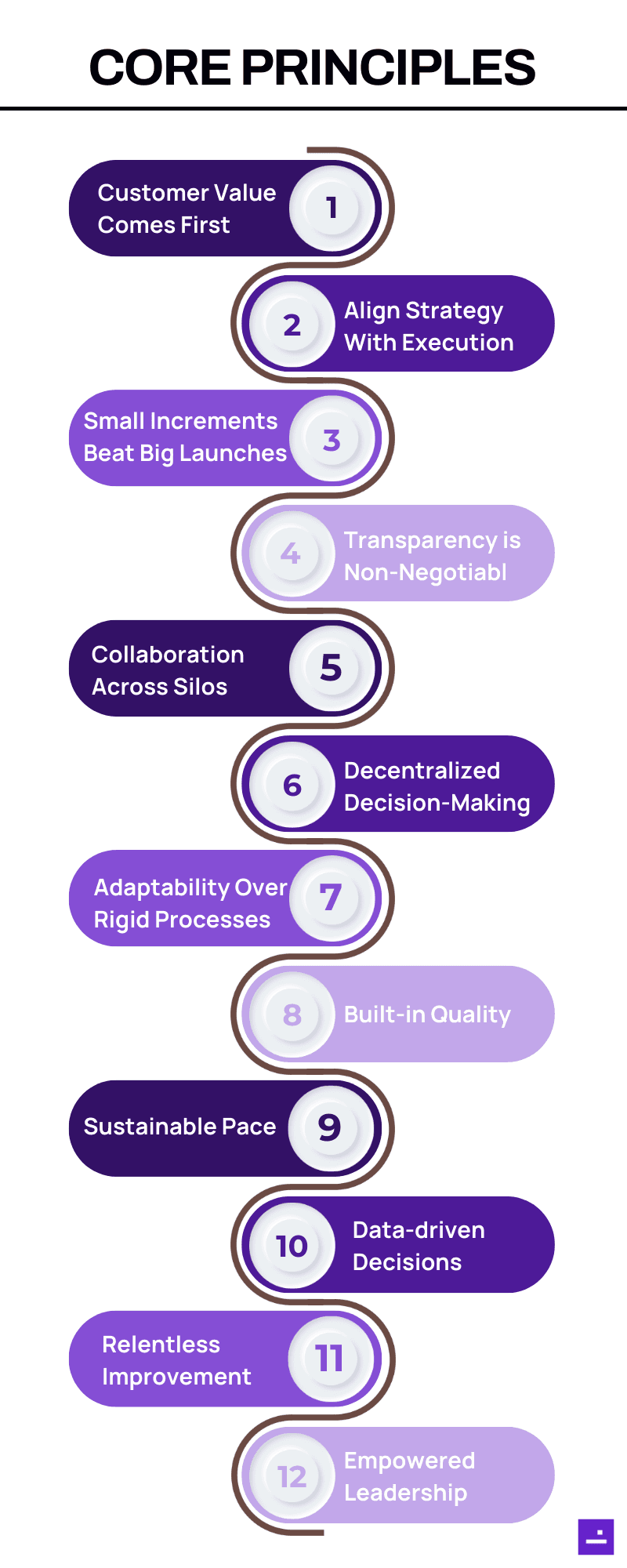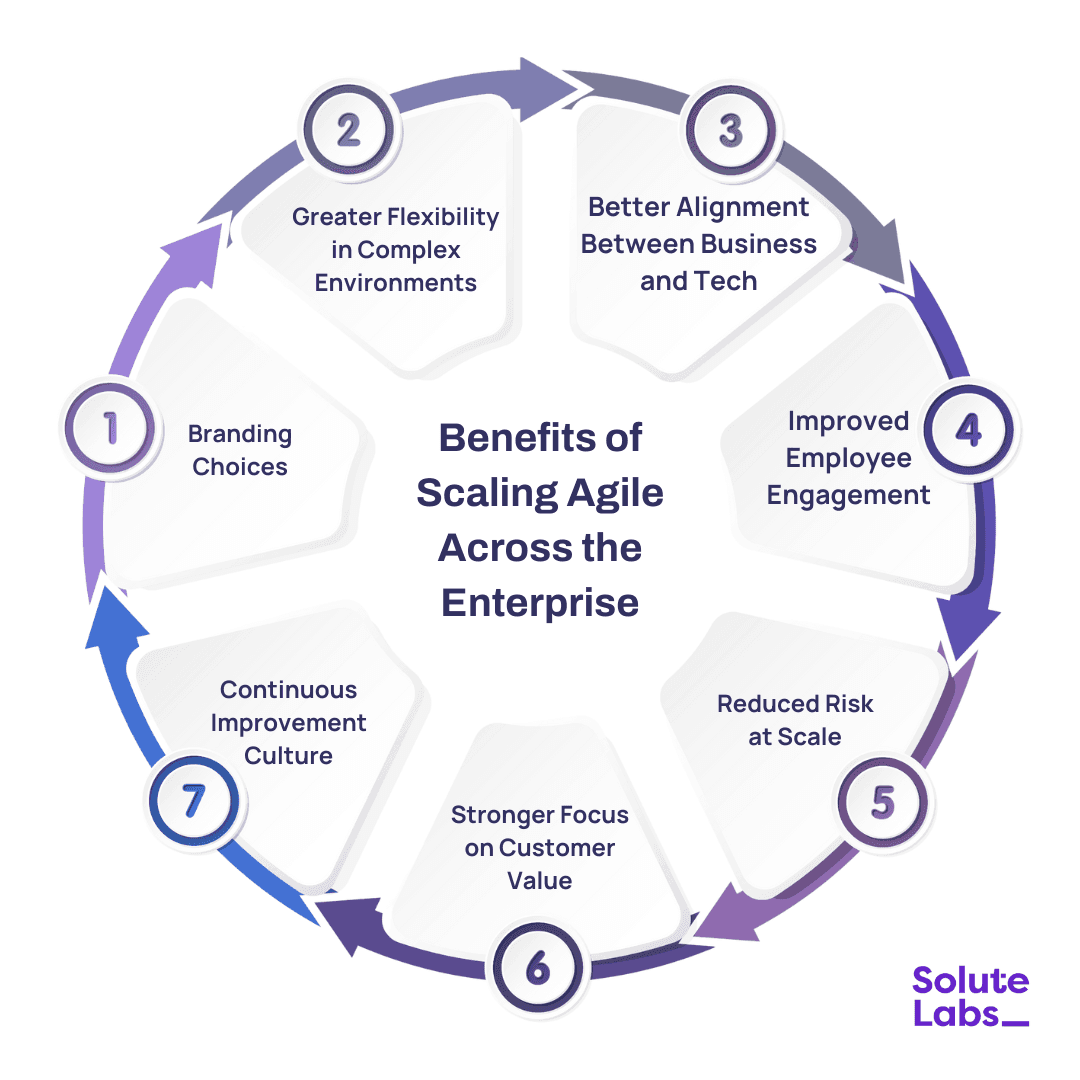Let’s be honest. When most people hear Agile, they imagine a small software team huddled around a whiteboard, sticky notes flying everywhere, and two-week sprints. That image works for startups, but here’s the twist: some of the biggest enterprises in the world are now running on Agile, and they’re doing it at a scale that sticky notes could never handle.
And it’s not just a buzzword anymore. According to the Digital.ai 17th State of Agile Report, 87% of organizations say they use Agile in some form today. That’s nearly nine out of ten companies. Crazy, right?
But here’s where it gets tricky. Enterprises aren’t startups. They’ve got legacy systems, red tape, global teams spread across time zones, and customer demands that change faster than budgets do. Traditional project methods (hello, Waterfall) just don’t cut it anymore.
That’s where enterprise agile product development comes in. It’s not about copying what a startup does; it’s about reimagining Agile so it actually works at enterprise scale. Over the next sections, we’ll unpack what that looks like, why it matters, and how large organizations can make Agile stick without losing their sanity.
Redefining Agile for the Enterprise
Agile sounds simple when you picture a small team. A few devs, maybe a designer, quick stand-ups, and sticky notes on a board. That’s the textbook version most people imagine.
But now, picture this instead: a Fortune 500 company with teams spread across New York, London, and Bangalore. Thousands of employees, dozens of product lines, multiple layers of management. Suddenly, “just do a sprint” doesn’t cut it anymore.
That’s why people talk about enterprise agile. It’s basically Agile grown up. The same agile principles for enterprise still apply: collaboration, flexibility, and delivering value fast, but they need to be reinterpreted when you’re operating at scale.
Here’s how it changes in real life:
- You don’t just have one Product Owner. You’ve got product leaders, portfolio managers, and release train engineers all trying to steer the ship.
- You don’t rely on sticky notes. You’ve got enterprise agile planning tools that map dependencies across hundreds of people.
- You don’t just run a sprint. You run dozens of them in sync, across time zones, all feeding into the same product vision.
And here’s the messy part: scaling Agile isn’t about slapping a framework on and calling it a day. It’s about shifting the culture. Teams need to be okay with experimentation. Leaders need to stop clinging to control. The organization has to move from “big-bang launches” to “incremental delivery.”
If you pull it off, though? That’s when enterprise agile transformation really shines. Big companies suddenly get the ability to act like startups, pivot fast, keep customers happy, and stay ahead of markets that don’t sit still for long.
Why Agile Product Development Matters for Large Organizations?
So why are big companies even bothering with Agile? I mean, they’ve been running on Waterfall or other traditional models for decades. Why fix what’s not broken?
Well… it is broken. At least in today’s world.
Large organizations deal with insane complexity, global supply chains, regulatory requirements, and customer bases in the millions. Add to that the fact that markets shift faster than ever. A customer trend can explode on TikTok today and vanish by next month. If you’re stuck in a 12–18 month release cycle, you’re already late to the party.
That’s the core reason enterprise agile product development matters. It gives organizations the ability to adapt quickly without losing control. Think about it like this:
- In a bank, Agile means rolling out new mobile app features every few weeks instead of every few years.
- In healthcare, it means updating digital patient portals in response to real-world feedback, not waiting for a massive overhaul.
- In retail, it means experimenting with AI-driven personalization on e-commerce platforms, and tweaking it live, rather than planning for “Version 2.0” next year.
Here’s the truth: Agile for large organizations is less about speed for the sake of speed and more about staying relevant. Customers don’t wait. Competitors don’t wait. Regulators don’t wait. If you can’t deliver value continuously, someone else will.
And it’s not just about products. Agile also impacts how teams think. When employees see that their ideas can turn into features within weeks, not years, engagement goes up. Silos break down. Leaders get better visibility. Everyone starts pulling in the same direction.
That’s why enterprise agile transformation has become more than a buzzword; it’s a survival strategy. Companies that figure it out don’t just launch faster. They learn faster. And in today’s world, learning faster usually means winning.
Also Read: How Agile and Outsourcing Can Be Better Together?
Core Principles of Enterprise-Grade Agile

Agile at the enterprise level isn’t just “do sprints and stand-ups.” It’s a mindset shift. And while every organization tweaks it to fit their reality, there are some enterprise agile principles that keep popping up again and again.
Let’s break them down without the jargon.
1. Customer Value Comes First
Every project, every sprint, every backlog item should tie back to delivering something the customer actually cares about. Not just features for the sake of features.
2. Align Strategy With Execution
Enterprises are notorious for having strategy in one silo and delivery in another. Enterprise agile planning forces alignment, so what leadership dreams up actually makes its way into working software.
3. Small Increments Beat Big Launches
Forget the 18-month “big bang” rollouts. In enterprise Agile, progress comes through continuous, bite-sized delivery that compounds over time.
4. Transparency is Non-Negotiable
Teams, leaders, and stakeholders need visibility. Dependencies, risks, budgets: everything should be out in the open. No surprises.
5. Collaboration Across Silos
Developers, designers, compliance officers, marketing, and everyone need a seat at the table. Silos kill agility faster than anything.
6. Decentralized Decision-Making
If every choice has to run up to the VP level, agility dies. Teams need autonomy to make real-time decisions within their scope.
7. Adaptability Over Rigid Processes
Frameworks like SAFe, LeSS, or Spotify are just tools. The principle is: adapt the framework to the enterprise, not the other way around.
8. Built-in Quality
Quality isn’t something you “test at the end.” It’s baked into the process, automation, CI/CD, security checks, and compliance guardrails.
9. Sustainable Pace
Burnout doesn’t scale. Agile at the enterprise level has to create rhythms that keep delivery steady without crushing teams.
10. Data-driven Decisions
Enterprises can’t run on gut feeling alone. Metrics, cycle time, release frequency, customer feedback, need to guide decisions.
11. Relentless Improvement
Retrospectives don’t stop being useful at scale. Enterprises that thrive with Agile build continuous learning into their DNA.
12. Empowered Leadership
Leaders aren’t there to micromanage; they’re there to unblock, align, and create conditions for agility to stick.
Here’s the big takeaway: Agile principles for enterprise aren’t all that different from the ones small teams use. The difference is in scale and complexity. At the enterprise level, these principles stop being “nice to haves” and become survival essentials.
Benefits of Scaling Agile Across the Enterprise

So, what’s the payoff? Why go through the pain of shifting thousands of people, retraining managers, and rethinking entire delivery models just to “go Agile”?
Because the benefits are real. And once they kick in, they compound. Let’s walk through the big ones.
1. Faster Time-to-Market
This is the obvious one. With scaling agile in enterprises, you’re not waiting for a massive launch every 18 months. Instead, value gets delivered in increments, sometimes weekly, sometimes even daily. Customers see improvements faster, and the company captures market opportunities before they vanish.
2. Greater Flexibility in Complex Environments
Markets shift, regulations change, competitors move fast. Enterprises can’t afford to stick to fixed roadmaps anymore. Agile gives them the ability to pivot, reprioritize, and still keep delivery moving without total chaos.
3. Better Alignment Between Business and Tech
How many times have you seen IT teams build something that doesn’t match what the business actually needed? With enterprise agile product development, business and delivery stay connected through constant feedback loops. That alignment alone saves millions.
4. Improved Employee Engagement
Here’s the underrated benefit: when employees actually see their work making an impact within weeks (instead of years), they’re more motivated. Agile doesn’t just change process; it changes culture.
5. Reduced Risk at Scale
Instead of gambling everything on a massive release, Agile spreads out risk. Small, incremental releases mean issues get caught early. Think of it as risk management built right into the process.
6. Stronger Focus on Customer Value
Agile forces enterprises to prioritize based on what drives customer value, not internal politics, not sunk costs. That means fewer vanity projects and more meaningful innovation.
7. Continuous Improvement Culture
Scaling Agile isn’t a “one-and-done” deal. Retrospectives, data-driven insights, and feedback loops make enterprises sharper over time. The longer they stick with it, the more efficient they get.
Here’s the kicker: the benefits of enterprise agile aren’t just operational, they’re strategic. Enterprises that master agility start to look and act like much smaller, faster companies… while keeping the advantages of scale. That’s a tough combo for competitors to beat.
Waterfall vs. Agile in Complex Enterprise Environments
If you’ve ever sat through a big enterprise project, you probably know how different Waterfall and Agile feel in practice. Waterfall can feel like a marathon where you only know if you’re winning at the finish line. Agile, on the other hand, is more like running sprints; you check progress often, adjust, and keep moving.
Let’s put them side by side, just to see how they really compare:
| What We’re Looking At | Waterfall Way | Agile Way (Enterprise-Scale) |
|---|---|---|
How it flows | One straight line: plan, design, build, test, launch | Loops of smaller cycles: build something, test it, learn, repeat. |
Handling change | Painful, once plans are locked, shifting costs time and money | Expected, change is part of the rhythm, not a disruption. |
When problems show up | Usually at the end, when it’s very late (and expensive) to fix. | Pretty early, because each cycle surfaces issues quickly. |
Value delivery | Users wait months (sometimes years) to see results. | Stakeholders see value rolling out every few weeks or months. |
Customer voice | Rarely heard until the final release. | Constantly included through feedback loops. |
Best suited for | Projects where requirements won’t really change (think compliance-heavy or infrastructure builds). | Complex, shifting environments where adaptability is survival. |
The Agile Product Development Process for Businesses
So, what does enterprise agile product development really look like in the real world? It's not enough to just "work in sprints" or "have daily stand-ups." At the enterprise level, the process is more organized, but it can still handle the chaos that comes with big companies.
Instead of a straight line, think of it as a circle. This is what it usually looks like:
- Vision and Alignment: Leaders don't give a hundred-page plan; they give a clear direction. The goal is to explain why the product exists and make sure that everyone on the team knows what it is all about. Without this step, Agile can turn into chaos, with teams going in different directions.
- Creating and Prioritizing a Backlog: Instead of locking everything in, businesses make a dynamic backlog. We put features, improvements, and fixes in order of importance based on how much they help customers, how well they follow the rules, and what the business wants to achieve. It's okay that priorities change all the time.
- Planning in Small Steps: Planning doesn't mean mapping out two years' worth of work like it used to. Businesses usually plan in three-month chunks, which are sometimes called "Program Increments" in frameworks like SAFe. This gives teams enough structure without forcing them to make promises they can't keep.
- Development in Iterations: Teams then work in short sprints that last two to three weeks. Each sprint gives you something useful, even if it's just a small part of a feature. If you do this with dozens of teams, you can see how value moves much faster than in the Waterfall.
- Continuous Testing and Integration: Businesses can't afford big failures. That's why every step includes testing, integration, and security checks instead of just the end.
- Review and Feedback Loops: After each sprint or increment, stakeholders and sometimes even customers look over the work. Feedback goes back into the backlog right away. This is how products change to meet the needs of the market.
- Deployment and Scaling: Many modern businesses use DevOps pipelines to push updates without any problems. There are a number of smaller, safer releases instead of one big one.
- Inspect and Adapt: At the end of each cycle, leaders and teams ask themselves, "What worked?" What didn't work? What has to change? This way of thinking about continuous improvement is what keeps enterprise agile going for a long time.
When you look at the big picture, the agile product development process that big companies use is less about following strict steps and more about keeping a steady pace. It's a rhythm of planning, building, testing, learning, and getting better that happens over and over again.
Best Practices for Enterprise Agile Implementation
Implementing Agile across a large organization isn’t just about picking a framework—it’s about making it stick. Many enterprises fail not because Agile doesn’t work, but because they try to apply it like a plug-and-play system. Here’s what actually helps it succeed:
- Start With Culture, Not Tools: Tools are helpful, but culture is everything. Teams need to feel safe experimenting, failing, and learning. Leadership must encourage autonomy while still keeping an eye on strategy. Without this, Agile becomes “fake Agile,” just a lot of meetings and charts.
- Train, Coach, Repeat: Even experienced teams benefit from training when scaling Agile. Coaches help teams adopt enterprise agile principles correctly and avoid reverting to old habits. Think of it as ongoing mentorship, not a one-off workshop.
- Prioritize Ruthlessly: Large organizations tend to over-plan. Focus on the work that delivers real customer value. Backlogs need constant grooming, and leadership must resist the urge to push everything at once.
- Keep Communication Flowing: When dozens of teams are involved, dependencies can get messy. Regular alignment meetings, transparent dashboards, and cross-team check-ins are vital. And don’t underestimate informal communication; hallway chats, Slack threads, and quick syncs help things move faster.
- Measure What Matters: Metrics should guide decisions, not punish people. Track delivery speed, cycle time, and customer satisfaction. Avoid vanity metrics that make executives feel good but don’t impact outcomes.
- Start Small, Scale Smart: Pilots are your friend. Roll out Agile with a few teams, learn the lessons, and then scale gradually. Enterprise-wide change rarely works if you try to do everything at once.
- Inspect, Adapt, Repeat: Agile is all about feedback. Retrospectives, after-action reviews, and lessons learned should happen at every level, from team to portfolio. Continuous improvement is the lifeblood of enterprise Agile.
The big takeaway? Best practices for enterprise agile aren’t a checklist; they’re habits. Habits that, when practiced consistently, turn chaos into flow and friction into results.
Real-World Case Studies of Agile at Scale
- Spotify: Teams were split into "squads" and "tribes," which let squads work on their own while still keeping everyone on the same page. The framework was important, but what really made it all work was a culture of ownership and working together.
- Bank ING: When ING switched from Waterfall to Agile, they started small and gave product owners more power. This method, along with good coaching, led to faster product releases and more engaged employees.
- Bosch: Bosch stressed openness and alignment when coordinating multiple software teams in different countries using SAFe. This method cut down on delays, made things better, and kept teams from being micromanaged.
The Future of Agile in Enterprise Transformation
Agile in enterprises is no longer just about IT teams running sprints. It’s shifting into something much bigger, a way for the whole organization to stay flexible when markets, technology, and customer needs keep changing. The future of enterprise agile transformation is less about processes on paper and more about whether a business can truly adapt when the unexpected happens.
One thing leaders are starting to realize is that Agile maturity isn’t the same everywhere. Some teams are great at adapting, while others still work in silos. That’s why the enterprise agile maturity model is becoming useful; it shows where a company actually stands, instead of assuming one size fits all.
Looking forward, Agile won’t stay in its current form. It’s going to mix with things like AI-driven insights, automation, and design thinking. Enterprises that treat it as a “checklist” will fall behind. The ones that use it as a mindset, as a way to make decisions faster, test ideas, and shift gears when needed, are the ones that will keep moving ahead.
Conclusion
Agile product development, at its core, isn’t complicated. It’s just about keeping things flexible enough so you can respond when plans change, which they always do. Teams that stick with it usually find they waste less time, stay more focused, and end up building products people actually want to use.
The real win, though, is how it keeps momentum alive. You don’t get bogged down in endless planning. Instead, you take smaller steps, learn from what works (and what doesn’t), and then keep moving forward. That rhythm makes it a lot easier to stay competitive without burning out your team.
At SoluteLabs, we’ve taken that same approach into the way we work with clients. Sometimes you just need an extra set of hands, or a full agile team on demand, to keep things moving. That’s where we step in, filling the gaps, speeding up delivery, and making sure quality doesn’t take a back seat.






